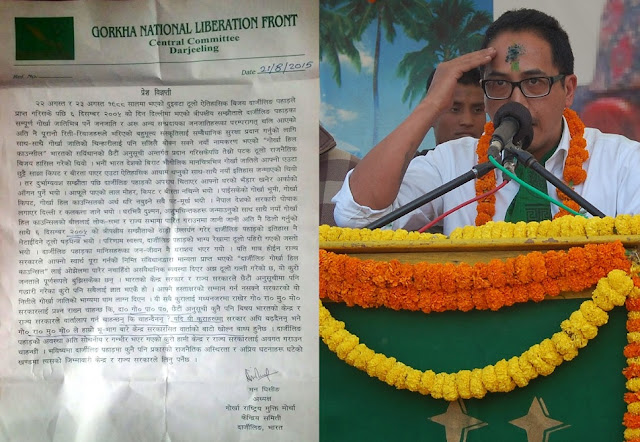Writes: Vivek Chhetri
The president of the Gorkha National Liberation Front in a press release today termed the traditional dress of the Nepali community as the the official dress of Nepal, eliciting criticism from all hill parties.
GNLF president Mann Ghisingh stated in the statement in Nepali: "The Darjeeling hills has failed to recognize its own land (that would have come through the inclusion of the area in the Sixth Schedule of the Constitution). Everybody became fools not to understand the Gorkha's own land and the Gorkha Hill Council. They started going to Delhi and Calcutta wearing the official dress of Nepal."
Mann's statement did not explain who the "they" referred to.
Many hill leaders have worn the traditional daura sural and chowbandi choli to meet state-level and central leaders on many occasions. Few years ago, the Morcha had issued a diktat making it compulsory for hill people to wear the attire for a month. Following backlash, it had removed the mandatory tag on the order.
"After having scored two major political victories, on August 22 and August 23, 1988, a third major political victory had been achieved by signing the tripartite agreement on December 6, 2005, to form the Gorkha Hill Council, that would have carried the distinct identity of the Indian Gorkhas," the signed statement reads.
The new council under the Sixth Schedule was to be named Gorkha Hill Council.
On August 22, 1988, the Darjeeling Gorkha Hill Council accord was signed and the next day, the Centre had issued a notification stating that all those living in India before 1950 were Indian citizens.
The GNLF is of the opinion that the citizenship issue of Gorkhas in India was clarified by the notification.
The GNLF's statement terming the traditional dress of daura sural and chowbandi choli as the official dress of Nepal has surprised others.
Binay Tamang, the assistant secretary of the Morcha said: "The dress is of our community and he (Mann Ghisingh) must clarify what we should wear now. Subash Ghisingh took our community behind by 25 years by indulging in controversies and now they are again taking our community behind by raking up unnecessary controversies."
Even ABGL and CPRM, allies of the GNLF in the newly-constituted Democratic Front, criticised the statement.
"This is not a correct statement. I hope the GNLF will ponder over the statement and rectify it," said Pratap Khati, general secretary of ABGL.
Govind Chhetri, spokesman of the CPRM, said: "The GNLF must retract and apologise for hurting the sentiments of the Indian Gorkhas."
Mann did not take calls today. Biren Lama, a central committee member of GNLF, said: "I don't think this is a controversial statement."
Towards the end of the press release, GNLF warns that the "Central and State Government will be responsible for any political instability in the future, and anything on toward happens in Darjeeling in the future."
Source: Telegraph
The president of the Gorkha National Liberation Front in a press release today termed the traditional dress of the Nepali community as the the official dress of Nepal, eliciting criticism from all hill parties.
 |
| GNLF president Mann Ghisingh controversal statement on traditional dress of Daura Sural and Chowbandi Choli -Photo of the press release via The Darjeeling Chronicle's |
GNLF president Mann Ghisingh stated in the statement in Nepali: "The Darjeeling hills has failed to recognize its own land (that would have come through the inclusion of the area in the Sixth Schedule of the Constitution). Everybody became fools not to understand the Gorkha's own land and the Gorkha Hill Council. They started going to Delhi and Calcutta wearing the official dress of Nepal."
Mann's statement did not explain who the "they" referred to.
Many hill leaders have worn the traditional daura sural and chowbandi choli to meet state-level and central leaders on many occasions. Few years ago, the Morcha had issued a diktat making it compulsory for hill people to wear the attire for a month. Following backlash, it had removed the mandatory tag on the order.
"After having scored two major political victories, on August 22 and August 23, 1988, a third major political victory had been achieved by signing the tripartite agreement on December 6, 2005, to form the Gorkha Hill Council, that would have carried the distinct identity of the Indian Gorkhas," the signed statement reads.
The new council under the Sixth Schedule was to be named Gorkha Hill Council.
On August 22, 1988, the Darjeeling Gorkha Hill Council accord was signed and the next day, the Centre had issued a notification stating that all those living in India before 1950 were Indian citizens.
The GNLF is of the opinion that the citizenship issue of Gorkhas in India was clarified by the notification.
The GNLF's statement terming the traditional dress of daura sural and chowbandi choli as the official dress of Nepal has surprised others.
Binay Tamang, the assistant secretary of the Morcha said: "The dress is of our community and he (Mann Ghisingh) must clarify what we should wear now. Subash Ghisingh took our community behind by 25 years by indulging in controversies and now they are again taking our community behind by raking up unnecessary controversies."
Even ABGL and CPRM, allies of the GNLF in the newly-constituted Democratic Front, criticised the statement.
"This is not a correct statement. I hope the GNLF will ponder over the statement and rectify it," said Pratap Khati, general secretary of ABGL.
Govind Chhetri, spokesman of the CPRM, said: "The GNLF must retract and apologise for hurting the sentiments of the Indian Gorkhas."
Mann did not take calls today. Biren Lama, a central committee member of GNLF, said: "I don't think this is a controversial statement."
Towards the end of the press release, GNLF warns that the "Central and State Government will be responsible for any political instability in the future, and anything on toward happens in Darjeeling in the future."
Source: Telegraph








.jpg)



